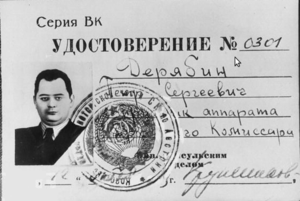Peter Deriabin

Peter Deriabin (1921-1992) (Петр Дерябин) was a Russian Communist Party member, World War II veteran, SMERSH agent, and KGB agent who later defected to the United States. He started working for the Central Intelligence Agency, went to graduate school, and wrote several books on the KGB. He died in 1992 at age 71.[2]
He was a member of the Communist Party. He went to Biysk Teachers College as well as the Institute for Marxism-Leninism.[2] In World War II he was wounded four times and reassigned to the Soviet Navy's SMERSH (military counterintelligence group). He was later an investigator in State Security. He eventually moved up to the KGB headquarters.[3]
In 1953, he was stationed in Vienna, Austria as Chief of Soviet Counterintelligence as well as Communist Party boss for the entire Austro-German section. In 1954, he defected to the United States.[4] In retaliation, the Military Collegium of the Supreme Court of the USSR gave him a death sentence.[2] He testified before the Senate and the HUAC in 1959, and cowrote a book about his time in the KGB.[5]
He also went to graduate school at the University of Michigan and the University of Virginia.[2] He also joined the CIA.
A few days after the assassination of President Kennedy, Deriabin wrote a lengthy memorandum for the CIA.[6] In it he theorized that Oswald was a Russian KGB agent who either was dispatched to kill Kennedy or was sent to the United States on a different mission and then committed the assassination on his own. Deriabin contended that the Russians would have accomplished several objectives by eliminating Kennedy. Among them was removing the West's preeminent cold warrior from the scene; constraining US covert actions against Cuba, which would be stigmatized as acts of vengeance; and divert the Russian people's attentions from their many domestic problems.
He was also involved in the Yuri Nosenko case, a controversial Russian defector who was treated harshly by the CIA (including solitary confinement) and presumed to be a KGB plant for at least a year before he was released. Deriabin was one of the CIA officials who believed he was a plant. He claimed that the details of Nosenko's stories about his experiences in SMERSH and the KGB didn't match up with Deriabin's own experience in those agencies.[3]
Deriabin was considered an asset when the NSA ramped up operations in the 1970s. Deriabin was welcomed to the NSA family during a visit to Fort Meade in 1973. A detailed report of his visit was declassified in 2012.*
Deriabin retired from the CIA in 1981.[2]
At the time of his death, he was survived by family members whose names were kept secret by the CIA.[2]
Books
He cowrote several books.
- The Secret World, with Frank Gibney, Doubleday, 1959
- Watchdogs of Terror, 1984, University Publications of America.[7]
- "KGB, Masters of the Soviet Union", with Tennent H. Bagley, Hippocrene Books, 1990[8]
- The Spy Who Saved The World, with Jerrold L Schecter, Scribners, 1992[9]
- Inside Stalin's Kremlin, Brasseys Publications, 1998 [10]
- Deriabin gave a detailed account of his views on the Nosenko case to Tennet H. Bagley, which were published in Bagley's book "Spy Wars", released in 2007.[3]
References
- ↑ KGB Identity Card, originally from Life Magazine Jan 01, 1959, copyright exempt because of commons:Template:PD-RU-exempt
- 1 2 3 4 5 6 Peter Deriabin, 71, A Moscow Defector Who Joined C.I.A. Published: August 31, 1992, New York Times
- 1 2 3 Bagley, Tennent H. (2007), Spy Wars: Moles, Mysteries, and Deadly Games, Yale University Press (also available on audio, read by Bagley)
- ↑ A Soviet Defector at NSA Archived 2013-09-18 at the Wayback Machine.
- ↑ Postwar Soviet Espionage, a Bibliography, vol 6 n 2. Center for the Study of Intelligence, CIA, p A35
- ↑ DCI John McCone and the Assassination of President John F. Kennedy, p. 3. Studies in Intelligence vol. 57, no. 3 (September 2013)
- ↑ Watchdogs of terror: Russian bodyguards from the tsars to the commissars, Peter Deriabin, University Publications of America, 1984. google books
- ↑ The KGB: Masters of the Soviet Union by Peter Deriabin with Tennent Bagley, 1990
- ↑ Schecter, Jerrold L.; Deriabin, Peter S. (1992). The Spy Who Saved the World: How a Soviet Colonel Changed the Course of the Cold War. New York: C. Scribner's Sons. p. 284. ISBN 978-0-684-19068-6.
- ↑ Inside Stalin's Kremlin, Brasseys Publications, 1998